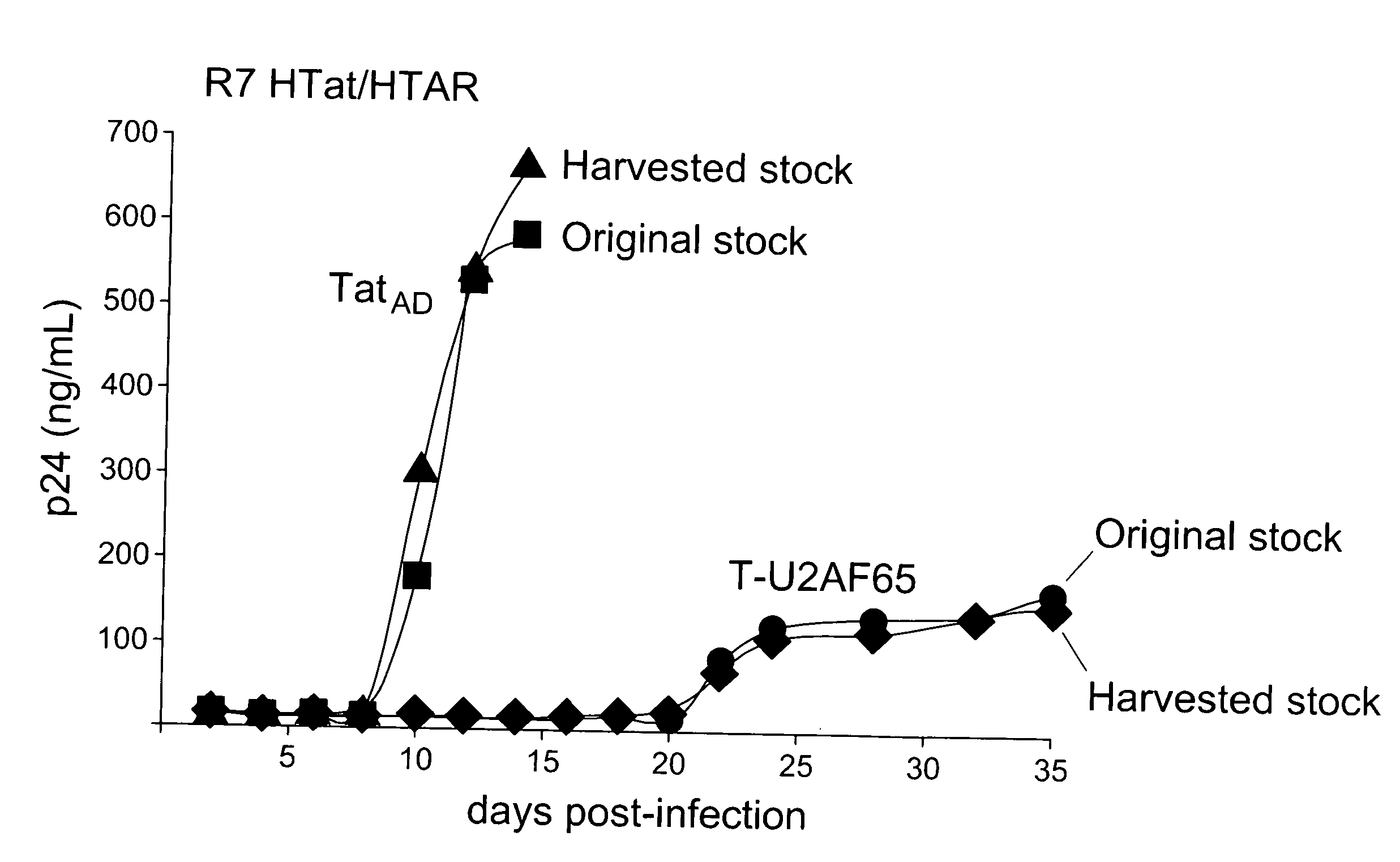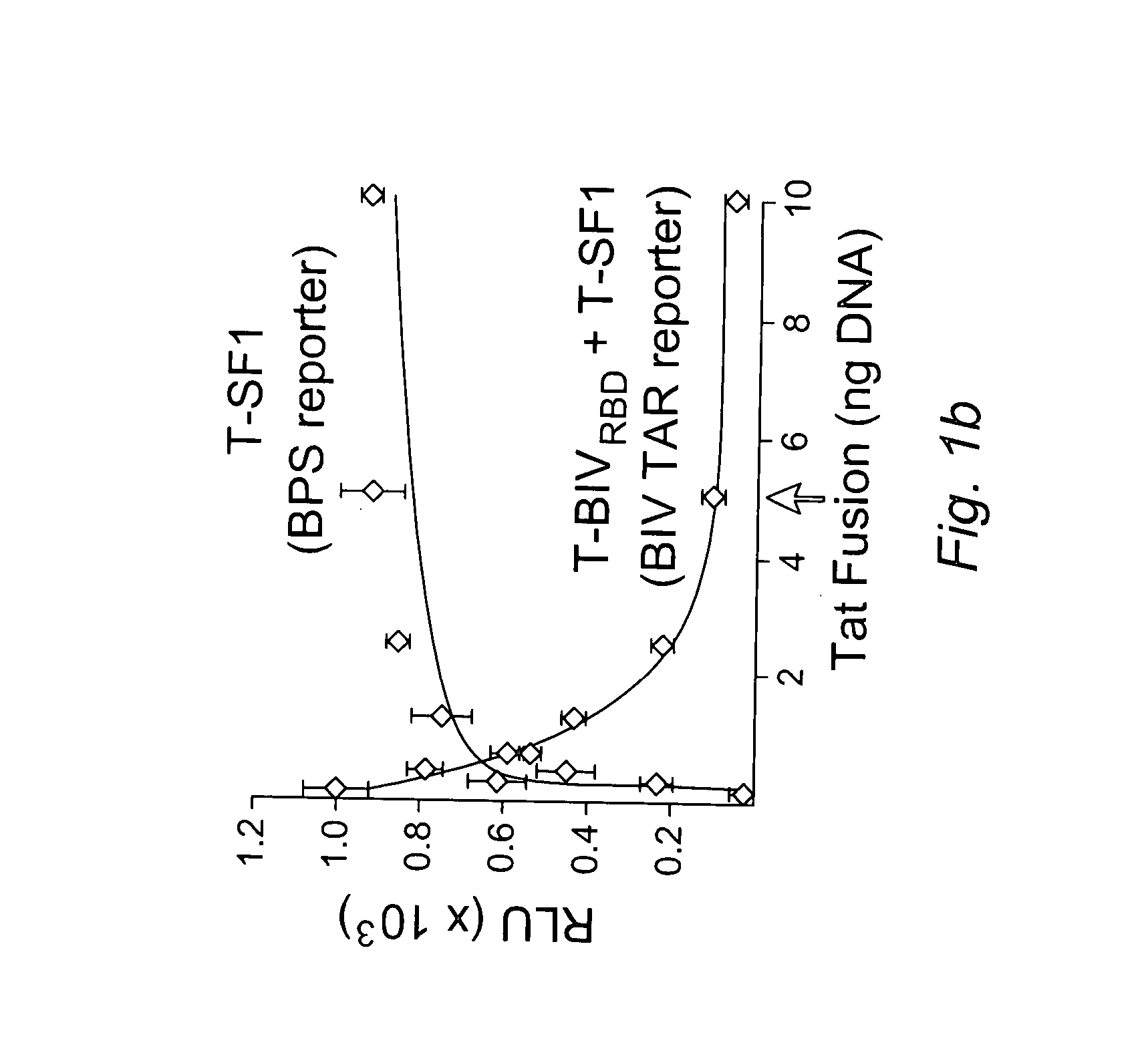Generation of potent dominant negative transcriptional inhibitors
a transcriptional inhibitor and dominant technology, applied in the field of generation of potent dominant negative transcriptional inhibitors, can solve the problems of congenital heart defects, ineffective immune system against various opportunistic effects, and abnormal development and various disease states
- Summary
- Abstract
- Description
- Claims
- Application Information
AI Technical Summary
Benefits of technology
Problems solved by technology
Method used
Image
Examples
example 1
Dominant Negative Inhibition of Transcription by Linking Tat to a Protein that Localizes to the Transcriptional Machinery
[0169] The Tat-hybrid assay, in which Tat fused to a heterologous RNA-binding domain (RBD) elicits activation of an HIV-1 LTR reporter plasmid containing a cognate RNA-binding site, has been useful for studying RNA-protein interactions in living cells6. However, as with other types of fusion protein assays, dominant negative proteins can be generated unintentionally that score as false negatives. We discovered a novel class of highly potent dominant negatives, exemplified by Tat fusions to splicing factors, whose potency appears to be dictated by cotranscriptional recruitment to the HIV promoter.
[0170] We devised a dual-fluorescence Tat-hybrid assay to monitor RNA-binding specificity using two pairs of orthogonal reporters and Tat fusions, herein referred to as T-fusions. To calibrate the assay, T-BIVRBD , a fusion between the HIV Tat activation domain (AD) and ...
example 2
Effect of Localization of the Dominant Negative Protein on Inhibition of Transcription
[0174] To begin examining the effect of localization on inhibitor activity, we first asked whether nuclear localization alone might account for some of its potency, particularly because a variety of T-fusions showed activity, albeit not as strong as T-U2AF65 (FIG. 7). We generated T-fusions to GFP with or without a nuclear localization signal (NLS) and observed very weak dominant negative activity for the AD fusion alone (T-GFP) and only slightly enhanced inhibition for T-NLS-GFP (FIG. 2a). This result is consistent with the mild dominant negative phenotype observed for a Tat 1-53 truncation mutant that deletes part of the RNA-binding domain but still retains an NLS5. In contrast, T-U2AF65-GFP is a highly potent inhibitor (FIG. 2a), indicating that nuclear localization is not the major factor contributing to potency. T-GFP is distributed in the cytoplasm and nucleus, like unfused GFP, whereas T-NL...
example 3
Recruitment of the Dominant Negative Protein to the Transcriptional Machinery
[0176] To examine the recruitment of T-U2AF65 to the transcriptional machinery, we first analyzed possible interactions with RNAP II by co-immunoprecipitation using antibodies against the Ser5-phosphorylated CTD (Ser5P-CTD), known as RNAP IIa. T-U2AF65-GFP, as well as the K41A Tat AD mutant, are complexed with RNAP IIa in a RNA-independent manner (FIG. 3a). Strikingly, no interaction is seen with T-NLS-GFP lacking the U2AF65 moiety despite the reported interaction of Tat with RNAP II in vitro13. Identical results were obtained using antibodies that recognize RNAP II with unphosphorylated CTD (data not shown). Thus, it appears that the U2AF65 RS moiety localizes the inhibitor to transcription complexes more efficiently than the Tat AD, consistent with the observations that U2AF65 interacts with RNAP II7 and that fusing an RS domain to a cytoplasmic reporter protein results in nuclear localization and intera...
PUM
| Property | Measurement | Unit |
|---|---|---|
| transcriptional elongation | aaaaa | aaaaa |
| nucleic acid | aaaaa | aaaaa |
Abstract
Description
Claims
Application Information
 Login to View More
Login to View More - R&D
- Intellectual Property
- Life Sciences
- Materials
- Tech Scout
- Unparalleled Data Quality
- Higher Quality Content
- 60% Fewer Hallucinations
Browse by: Latest US Patents, China's latest patents, Technical Efficacy Thesaurus, Application Domain, Technology Topic, Popular Technical Reports.
© 2025 PatSnap. All rights reserved.Legal|Privacy policy|Modern Slavery Act Transparency Statement|Sitemap|About US| Contact US: help@patsnap.com



